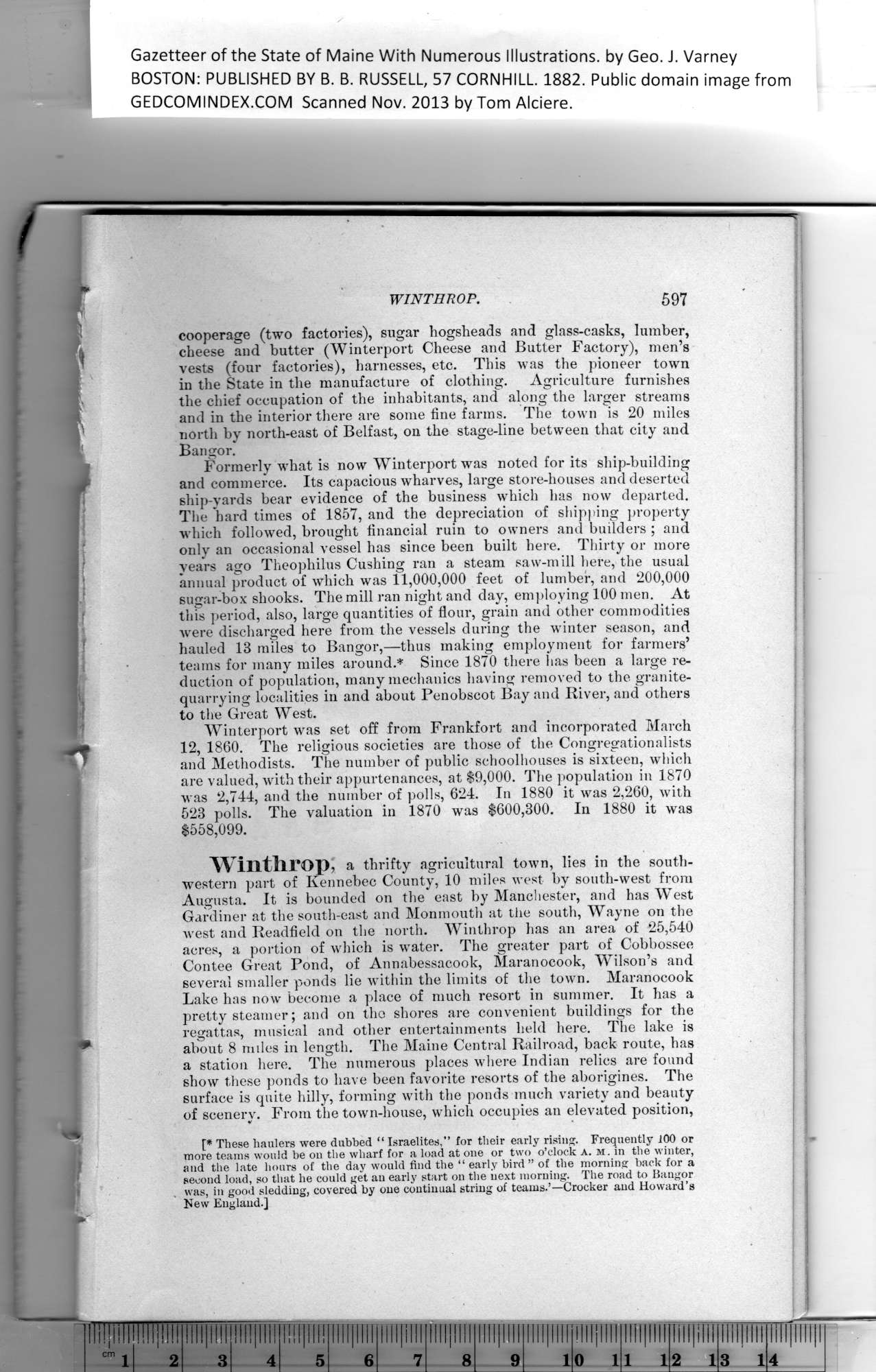|
Gazetteer of the State of Maine With Numerous Illustrations, by Geo. J. Varney
BOSTON: PUBLISHED BY B. B. RUSSELL, 57 CORNHILL. 1882. Public domain image from
WINTHROP. 597
cooperage (two factories), sugar hogsheads and glass-casks, lumber,
cheese and butter (Winterport Cheese and Butter Factory), men’s
vests (four factories), harnesses, etc. This was the pioneer town
in the State in the manufacture of clothing. Agriculture furnishes
the chief occupation of the inhabitants, and along the larger streams
and in the interior there are some fine farms. The town is 20 miles
north by north-east of Belfast, on the stage-line between that city and
Bangor.
Formerly what is now Winterport was noted for its ship-building
and commerce. Its capacious wharves, large store-houses and deserted
ship-yards bear evidence of the business which has now departed.
The hard times of 1857, and the depreciation of shipping property
which followed, brought financial ruin to owners and builders ; and
only an occasional vessel has since been built here. Thirty or more
years ago Theophilus Cushing ran a steam saw-mill here, the usual
annual product of which was 11,000,000 feet of lumber, and 200,000
sugar-box sliooks. The mill ran night and day, employing 100 men. At
tins period, also, large quantities of flour, grain and other commodities
were discharged here from the vessels during the winter season, and
hauled 13 miles to Bangor,—thus making employment for farmers’
teams for many miles around.* Since 1870 there has been a large re-
duction of population, many mechanics having removed to the granite-
quarrying localities in and about Penobscot Bay and River, and others
to the Great West.
Winterport was set off from Frankfort and incorporated March
12, 1860. The religious societies are those of the Congregationalists
and Methodists. The number of public schoolhouses is sixteen, which
are valued, with their appurtenances, at $9,000. The population in 1870
was 2,744, and the number of polls, 624. In 1880 it was 2,260, with
523 polls. The valuation in 1870 was $600,300. In 1880 it was
$558,099.
Winthrop, a thrifty agricultural town, lies in the south-
western part of Kennebec County, 10 miles west by south-west from
Augusta. It is bounded on the east by Manchester, and has West
Gardiner at the south-east and Monmouth at the south, Wayne on the
Avest and Readfield on the north. Winthrop has an area of 25,540
acres, a portion of which is water. The greater part of Cobbossee
Contee Great Pond, of Annabessacook, Maranocook, Wilson’s and
several smaller ponds lie within the limits of the town. Maranocook
Lake has now become a place of much resort in summer. It has a
pretty steamer; and on the shores are convenient buildings for the
regattas, musical and other entertainments held here. The lake is
about 8 miles in length. The Maine Central Railroad, back route, has
a station here. The numerous places where Indian relics are found
show these ponds to have been favorite resorts of the aborigines. The
surface is quite hilly, forming with the ponds much variety and beauty
of scenery. From the town-house, which occupies an elevated position,
[* These haulers were dubbed “ Israelites,” for their early rising. Frequently 100 or
more teams would be on tbe wharf for a load at one or two o’clock a. m. in tbe winter,
and tbe late hours of tbe day would find the “ early bird” of tbe morning back for a
second load, so that be could get an early start on tbe next morning. The road to Bangor
was, in good sledding, covered by one continual string of teams.’—Crocker aud Howard’s
New England.]
PREVIOUS PAGE ... NEXT PAGE
This page was written in HTML using a program written in Python 3.2
|
